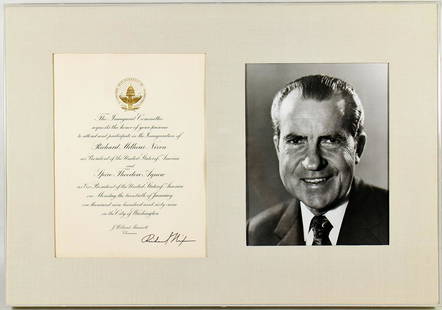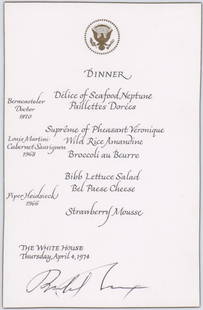
Richard Nixon on Diplomacy in the Nuclear Parity Era
Similar Sale History
View More Items in Political Memorabilia

Related Political Memorabilia
More Items in Political Memorabilia
View MoreRecommended Historical Memorabilia
View More





Item Details
Description
Nixon Richard
Richard Nixon on Diplomacy in the Nuclear Parity Era
Business card printed "Richard Nixon / 26 Federal Plaza / New York, New York 10278" initialed by former 37th U.S. President Richard Nixon (1913-1994) as “RN” in felt-tip pen at center. With two pristine copies of Nixon articles that were probably enclosed with the business card sometime during the fall of 1985. A minor rusted paperclip impression along the top of the business card, else near fine.
Ex-president Richard Nixon moved into a 15-room office on the 13th floor of 26 Federal Plaza in lower Manhattan in 1980. He and about half a dozen employees would work in the office facing Foley Square until 1988. On an average day, Nixon would typically arrive at the office by 7 am and leave by 6 pm; he spent the day writing, attending meetings and appointments, and signing autographs. Nixon might have written "Superpower Summitry" and "How to Live with the Bomb" at the New York office.
Richard Nixon's 11pp article "Superpower Summitry" was published in the Fall 1985 issue of Foreign Affairs. In it, Nixon advocated diplomacy as the best way to preserve peace during an era of nuclear parity. Whereas previously peace had been maintained through the fear that one party had more nuclear weapons capabilities, that was no longer the case in 1985. Face-to-face encounters arranged between rival leaders ensured that the two would follow the same rules. Nixon concluded that at the end of the day, this was the best possible result that could be achieved between two leaders with opposing viewpoints.
In part: "In these strategic circumstances, summit meetings between leaders of the United States and the Soviet Union have become essential if peace is to be preserved. Such meetings will contribute to the cause of peace, however, only if both leaders recognize that tensions between the two nations are due not to the fact that we do not understand each other but to the fact that we do understand that we have diametrically opposed ideological and geopolitical interests. Most of our differences will never be resolved. But the United States and the Soviet Union have one major goal in common: survival. Each has the key to the other's survival. The purpose of summit meetings is to develop rules of engagement that could prevent our profound differences from bringing us into armed conflict that could destroy us both." (Richard M. Nixon, "Superpower Summitry" (p. 1-11), Foreign Affairs, Vol. 64, No. 1, p. 1)
During his presidency, Nixon met with Soviet leader Leonid Brezhnev (1906-1982) in three highly successful summits. The two met in Moscow in May 1972 and June 1974, and at Nixon's Western White House in June 1973. Their intimate talks resulted in nothing short of SALT I (Strategic Arms Limitation Talks), the Anti-Ballistic Missile Treaty, and the Threshold Test Ban Treaty. Nixon's foreign relations policy had changed little from 1969, when he had stated in his inaugural speech that there was no substitute for diplomacy.
Richard Nixon's 5,000-word 7pp article "How to Live with the Bomb" appeared in the conservative weekly the National Review around the same time. In the article, Nixon reiterated most of the major points of "Superpower Parity."
In part: "But in the final analysis, there can be no real peace or real security in the world unless a new live-and-let-live relationship is established between the United States and the Soviet Union. For those who dislike the word 'détente,' perhaps 'cold peace' will do. Either is preferable to hot war." (Richard M. Nixon, "How to Live with the Bomb," National Review, September 20, 1985).
Nixon had been out of public office for over 10 years in 1985. Yet, as we know from these articles, he was still very active in current affairs. The ex-president devoted himself to writing, traveling, and speaking engagements in the years following his resignation. Nixon's repentance about past mistakes, as well as his later political involvement, did much to rehabilitate his tarnished public image.
This item comes with a Certificate from John Reznikoff, a premier authenticator for both major 3rd party authentication services, PSA and JSA (James Spence Authentications), as well as numerous auction houses.
WE PROVIDE IN-HOUSE SHIPPING WORLDWIDE.
Richard Nixon on Diplomacy in the Nuclear Parity Era
Business card printed "Richard Nixon / 26 Federal Plaza / New York, New York 10278" initialed by former 37th U.S. President Richard Nixon (1913-1994) as “RN” in felt-tip pen at center. With two pristine copies of Nixon articles that were probably enclosed with the business card sometime during the fall of 1985. A minor rusted paperclip impression along the top of the business card, else near fine.
Ex-president Richard Nixon moved into a 15-room office on the 13th floor of 26 Federal Plaza in lower Manhattan in 1980. He and about half a dozen employees would work in the office facing Foley Square until 1988. On an average day, Nixon would typically arrive at the office by 7 am and leave by 6 pm; he spent the day writing, attending meetings and appointments, and signing autographs. Nixon might have written "Superpower Summitry" and "How to Live with the Bomb" at the New York office.
Richard Nixon's 11pp article "Superpower Summitry" was published in the Fall 1985 issue of Foreign Affairs. In it, Nixon advocated diplomacy as the best way to preserve peace during an era of nuclear parity. Whereas previously peace had been maintained through the fear that one party had more nuclear weapons capabilities, that was no longer the case in 1985. Face-to-face encounters arranged between rival leaders ensured that the two would follow the same rules. Nixon concluded that at the end of the day, this was the best possible result that could be achieved between two leaders with opposing viewpoints.
In part: "In these strategic circumstances, summit meetings between leaders of the United States and the Soviet Union have become essential if peace is to be preserved. Such meetings will contribute to the cause of peace, however, only if both leaders recognize that tensions between the two nations are due not to the fact that we do not understand each other but to the fact that we do understand that we have diametrically opposed ideological and geopolitical interests. Most of our differences will never be resolved. But the United States and the Soviet Union have one major goal in common: survival. Each has the key to the other's survival. The purpose of summit meetings is to develop rules of engagement that could prevent our profound differences from bringing us into armed conflict that could destroy us both." (Richard M. Nixon, "Superpower Summitry" (p. 1-11), Foreign Affairs, Vol. 64, No. 1, p. 1)
During his presidency, Nixon met with Soviet leader Leonid Brezhnev (1906-1982) in three highly successful summits. The two met in Moscow in May 1972 and June 1974, and at Nixon's Western White House in June 1973. Their intimate talks resulted in nothing short of SALT I (Strategic Arms Limitation Talks), the Anti-Ballistic Missile Treaty, and the Threshold Test Ban Treaty. Nixon's foreign relations policy had changed little from 1969, when he had stated in his inaugural speech that there was no substitute for diplomacy.
Richard Nixon's 5,000-word 7pp article "How to Live with the Bomb" appeared in the conservative weekly the National Review around the same time. In the article, Nixon reiterated most of the major points of "Superpower Parity."
In part: "But in the final analysis, there can be no real peace or real security in the world unless a new live-and-let-live relationship is established between the United States and the Soviet Union. For those who dislike the word 'détente,' perhaps 'cold peace' will do. Either is preferable to hot war." (Richard M. Nixon, "How to Live with the Bomb," National Review, September 20, 1985).
Nixon had been out of public office for over 10 years in 1985. Yet, as we know from these articles, he was still very active in current affairs. The ex-president devoted himself to writing, traveling, and speaking engagements in the years following his resignation. Nixon's repentance about past mistakes, as well as his later political involvement, did much to rehabilitate his tarnished public image.
This item comes with a Certificate from John Reznikoff, a premier authenticator for both major 3rd party authentication services, PSA and JSA (James Spence Authentications), as well as numerous auction houses.
WE PROVIDE IN-HOUSE SHIPPING WORLDWIDE.
Buyer's Premium
- 25%
Richard Nixon on Diplomacy in the Nuclear Parity Era
Estimate $300 - $400
1 bidder is watching this item.
Shipping & Pickup Options
Item located in Westport, CT, usSee Policy for Shipping
Payment

Auction Curated By

President
Related Searches
TOP






















































![10 Days After His Assassination JFK Signed W. H. letter, Fantastic! Among JFK's Last Acts in White H: John F. Kennedy[Washington, D.C.], December 2, 196310 Days After His Assassination JFK Signed W. H. letter, Fantastic! Among JFK's Last Acts in White House Post Dated Before Dallas TripTLSJOHN F. KENN](https://p1.liveauctioneers.com/6306/327579/176471594_1_x.jpg?height=310&quality=70&version=1714074043)








![Reagan Presidential "Camp David" Pickard China Dinner Plate: Presidential[Camp David], n.d.Reagan Presidential "Camp David" Pickard China Dinner PlateTablewareA Pickard China (Antioch, Illinois) dinner plate, almost certainly dating from the Reagan ad](https://p1.liveauctioneers.com/6306/327579/176471666_1_x.jpg?height=310&quality=70&version=1714074043)













